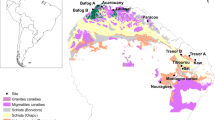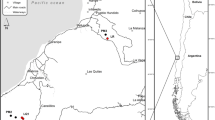Abstract
Plant species diversity increases as soil phosphorus availability declines during long-term ecosystem development1,2. The increase in plant species diversity is associated with a decline in above-ground functional diversity, because leaf traits converge on a high phosphorus-use efficiency strategy on old and infertile soils3,4. In contrast, the response of below-ground traits that directly influence nutrient acquisition remains poorly understood3,5; yet it might be key to understanding how soil fertility drives patterns of plant species diversity1. Here we show a marked increase in the richness and diversity of plant nutrient-acquisition strategies with declining soil phosphorus availability during long-term ecosystem development in a global biodiversity hotspot. Almost all nutrient-acquisition strategies currently known were found in plants from the most infertile soils, despite these being some of the most phosphorus-impoverished soils on Earth. Mycorrhizal plants declined in relative abundance by >30%, although the decline was compensated by an increase in non-mycorrhizal, carboxylate-exuding species that ‘mine’ phosphorus from the soil using different strategies. Plant species richness within individual nutrient-acquisition strategies also increased dramatically, with the species richness of many strategies more than doubling between the youngest and oldest soils. These results reveal increasing functional diversity of below-ground traits related to nutrient acquisition during ecosystem development, suggesting that no single combination of traits, including those related to nutrient-acquisition strategies, is superior to all others at extremely low soil fertility. Furthermore, the increasing diversity of nutrient-acquisition strategies with declining soil fertility, despite functional convergence of above-ground traits4,6, suggests that fundamentally different plant community assembly processes operate above- and below-ground.
This is a preview of subscription content, access via your institution
Access options
Subscribe to this journal
Receive 12 digital issues and online access to articles
$119.00 per year
only $9.92 per issue
Buy this article
- Purchase on Springer Link
- Instant access to full article PDF
Prices may be subject to local taxes which are calculated during checkout



Similar content being viewed by others
References
Laliberté, E. et al. How does pedogenesis drive plant diversity? Trends Ecol. Evol. 28, 331–340 (2013).
Wardle, D. A., Bardgett, R. D., Walker, L. R., Peltzer, D. A. & Lagerström, A. The response of plant diversity to ecosystem retrogression: evidence from contrasting long-term chronosequences. Oikos 117, 93–103 (2008).
Reich, P. B. The world-wide “fast–slow”plant economics spectrum: a traits manifesto. J. Ecol. 102, 275–301 (2014).
Mason, N. W. et al. Changes in coexistence mechanisms along a long-term soil chronosequence revealed by functional trait diversity. J. Ecol. 100, 678–689 (2012).
Mommer, L. & Weemstra, M. The role of roots in the resource economics spectrum. New Phytol. 195, 725–727 (2012).
Hayes, P., Turner, B. L., Lambers, H. & Laliberté, E. Foliar nutrient concentrations and resorption efficiency in plants of contrasting nutrient-acquisition strategies along a 2-million-year dune chronosequence. J. Ecol. 102, 396–410 (2014).
Rockström, J. et al. A safe operating space for humanity. Nature 461, 472–475 (2009).
Grime, J. P. Plant Strategies, Vegetation Processes, and Ecosystem Properties 2nd edn (Wiley, 2001).
Richardson, S. J., Peltzer, D. A., Allen, R. B., McGlone, M. S. & Parfitt, R. L. Rapid development of phosphorus limitation in temperate rainforest along the Franz Josef soil chronosequence. Oecologia 139, 267–276 (2004).
Lambers, H., Raven, J. A., Shaver, G. R. & Smith, S. E. Plant nutrient-acquisition strategies change with soil age. Trends Ecol. Evol. 23, 95–103 (2008).
Brundrett, M. C. Mycorrhizal associations and other means of nutrition of vascular plants: understanding the global diversity of host plants by resolving conflicting information and developing reliable means of diagnosis. Plant Soil 320, 37–77 (2009).
Dickie, I. A. et al. Mycorrhizas and mycorrhizal fungal communities throughout ecosystem development. Plant Soil 367, 11–39 (2013).
Shipley, B. From Plant Traits to Vegetation Structure: Chance and Selection in the Assembly of Ecological Communities (Cambridge Univ. Press, 2010).
Walker, T. W. & Syers, J. K. The fate of phosphorus during pedogenesis. Geoderma 15, 1–19 (1976).
Crews, T. E. et al. Changes in soil phosphorus fractions and ecosystem dynamics across a long chronosequence in Hawaii. Ecology 76, 1407–1424 (1995).
Laliberté, E. et al. Experimental assessment of nutrient limitation along a 2-million-year dune chronosequence in the south-western Australia biodiversity hotspot. J. Ecol. 100, 631–642 (2012).
Peltzer, D. A. et al. Understanding ecosystem retrogression. Ecol. Monogr. 80, 509–529 (2010).
Gotelli, N. J. & Colwell, R. K. Quantifying biodiversity: procedures and pitfalls in the measurement and comparison of species richness. Ecol. Lett. 4, 379–391 (2001).
Laliberté, E. & Legendre, P. A distance-based framework for measuring functional diversity from multiple traits. Ecology 91, 299–305 (2010).
Botta-Dukát, Z. Rao's quadratic entropy as a measure of functional diversity based on multiple traits. J. Veg. Sci. 16, 533–540 (2005).
Laliberté, E., Zemunik, G. & Turner, B. L. Environmental filtering explains variation in plant diversity along resource gradients. Science 345, 1602–1605 (2014).
Joner, E. J., Aarle, I. M. V. & Vosatka, M. Phosphatase activity of extra-radical arbuscular mycorrhizal hyphae: a review. Plant Soil 226, 199–210 (2000).
Smith, S. E. & Read, D. J. Mycorrhizal Symbiosis 3rd edn (Elsevier, 2008).
Turner, B. L. Resource partitioning for soil phosphorus: a hypothesis. J. Ecol. 96, 698–702 (2008).
Muler, A., Oliveira, R., Lambers, H. & Veneklaas, E. Does cluster-root activity benefit nutrient uptake and growth of co-existing species? Oecologia 174, 23–31 (2014).
Laliberté, E., Lambers, H., Burgess, T. I. & Wright, S. J. Phosphorus limitation, soil-borne pathogens and the coexistence of plant species in hyperdiverse forests and shrublands. New Phytol. 206, 507–521 (2015).
Holdaway, R. J., Richardson, S. J., Dickie, I. A., Peltzer, D. A. & Coomes, D. A. Species- and community-level patterns in fine root traits along a 120 000-year soil chronosequence in temperate rain forest. J. Ecol. 99, 954–963 (2011).
Cornwell, W. K. & Ackerly, D. D. Community assembly and shifts in plant trait distributions across an environmental gradient in coastal California. Ecol. Monogr. 79, 109–126 (2009).
Bonfante, P. & Anca, I. A. Plants, mycorrhizal fungi, and bacteria: a network of interactions. Annu. Rev. Microbiol. 63, 363–383 (2009).
R Development Core Team. R: A Language and Environment for Statistical Computing (R Foundation for Statistical Computing, 2013).
Acknowledgements
G.Z. was supported by a scholarship from the Paul Hasluck Bequest administered by the Kwongan Foundation. We acknowledge the assistance of many people in conducting the flora surveys. Funding was provided by research awards from UWA and a DECRA (DE120100352) from the Australian Research Council (ARC) to E.L. H.L. was supported by the Australian Research Council (ARC DP0985685). We thank D. Agudo and A. Bielnicka for laboratory support. We acknowledge the Department of Parks and Wildlife (Western Australia) and the Shires of Dandaragan, and Coorow for permission to conduct research on land under their administration. We acknowledge the facilities, and the scientific and technical assistance of the Australian Microscopy & Microanalysis Research Facility at the Centre for Microscopy, Characterisation & Analysis, The University of Western Australia, a facility funded by the University, State and Commonwealth Governments.
Author information
Authors and Affiliations
Contributions
G.Z. designed the study with assistance from E.L. and H.L. G.Z. collected the vegetation and mycorrhizal data, and performed the statistical analyses. E.L. and B.T. collected the soil data and B.T. analysed the soil samples. G.Z wrote the manuscript and all authors contributed to revisions.
Corresponding author
Ethics declarations
Competing interests
The authors declare no competing financial interests.
Supplementary information
Rights and permissions
About this article
Cite this article
Zemunik, G., Turner, B., Lambers, H. et al. Diversity of plant nutrient-acquisition strategies increases during long-term ecosystem development. Nature Plants 1, 15050 (2015). https://doi.org/10.1038/nplants.2015.50
Received:
Accepted:
Published:
DOI: https://doi.org/10.1038/nplants.2015.50
This article is cited by
-
The Responses of C Allocation of New Needle and Fine Root Affected the Phosphorus Adaptation of Pinus massoniana Seedlings
Journal of Soil Science and Plant Nutrition (2024)
-
Calcifuge and soil-indifferent Proteaceae from south-western Australia: novel strategies in a calcareous habitat
Plant and Soil (2024)
-
Dauciform roots affect functional traits of Carex filispica under nitrogen and phosphorus fertilization in alpine meadow
Scientific Reports (2023)
-
Rhizobium inoculation improves yield advantages and soil Olsen phosphorus by enhancing interspecific facilitation in intercropping
Plant and Soil (2023)
-
The response of two nutrient acquisition strategies: root traits and leaf nutrient resorption and their relationships to long-term mowing in a temperate steppe
Plant and Soil (2023)



